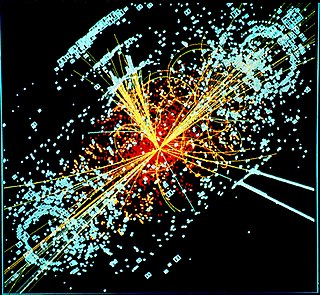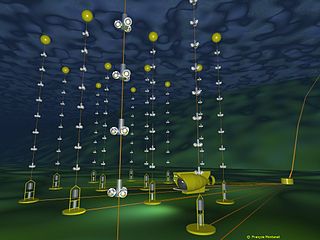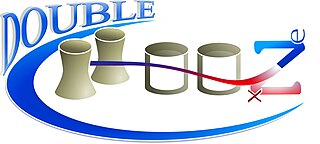
A neutrino is an elementary particle that interacts via the weak interaction and gravity. The neutrino is so named because it is electrically neutral and because its rest mass is so small (-ino) that it was long thought to be zero. The rest mass of the neutrino is much smaller than that of the other known elementary particles. The weak force has a very short range, the gravitational interaction is extremely weak due to the very small mass of the neutrino, and neutrinos do not participate in the electromagnetic interaction or the strong interaction. Thus, neutrinos typically pass through normal matter unimpeded and undetected.

Neutrino astronomy is the branch of astronomy that gathers information about astronomical objects by observing and studying neutrinos emitted by them with the help of neutrino detectors in special Earth observatories. It is an emerging field in astroparticle physics providing insights into the high-energy and non-thermal processes in the universe.

Neutrino oscillation is a quantum mechanical phenomenon in which a neutrino created with a specific lepton family number can later be measured to have a different lepton family number. The probability of measuring a particular flavor for a neutrino varies between three known states, as it propagates through space.

The IceCube Neutrino Observatory is a neutrino observatory developed by the University of Wisconsin–Madison and constructed at the Amundsen–Scott South Pole Station in Antarctica. The project is a recognized CERN experiment (RE10). Its thousands of sensors are located under the Antarctic ice, distributed over a cubic kilometer.

MiniBooNE is a Cherenkov detector experiment at Fermilab designed to observe neutrino oscillations. A neutrino beam consisting primarily of muon neutrinos is directed at a detector filled with 800 tons of mineral oil and lined with 1,280 photomultiplier tubes. An excess of electron neutrino events in the detector would support the neutrino oscillation interpretation of the LSND result.

A neutrino detector is a physics apparatus which is designed to study neutrinos. Because neutrinos only weakly interact with other particles of matter, neutrino detectors must be very large to detect a significant number of neutrinos. Neutrino detectors are often built underground, to isolate the detector from cosmic rays and other background radiation. The field of neutrino astronomy is still very much in its infancy – the only confirmed extraterrestrial sources as of 2018 are the Sun and the supernova 1987A in the nearby Large Magellanic Cloud. Another likely source is the blazar TXS 0506+056 about 3.7 billion light years away. Neutrino observatories will "give astronomers fresh eyes with which to study the universe".
Radio Ice Cherenkov Experiment (RICE) was an experiment designed to detect the Cherenkov emission in the radio regime of the electromagnetic spectrum from the interaction of high energy neutrinos with the Antarctic ice cap. The goals of this experiment are to determine the potential of the radio-detection technique for measuring the high energy cosmic neutrino flux, determining the sources of this flux, and measuring neutrino-nucleon cross sections at energies above those accessible with existing accelerators. Such an experiment also has sensitivity to neutrinos from gamma ray bursts, as well as highly ionizing charged particles traversing the Antarctic icecap.

ANTARES is a neutrino detector residing 2.5 km under the Mediterranean Sea off the coast of Toulon, France. It is designed to be used as a directional neutrino telescope to locate and observe neutrino flux from cosmic origins in the direction of the Southern Hemisphere of the Earth, a complement to the South Pole neutrino detector IceCube that detects neutrinos from both hemispheres. The experiment is a recognized CERN experiment (RE6). Other neutrino telescopes designed for use in the nearby area include the Greek NESTOR telescope and the Italian NEMO telescope, which are both in early design stages. The data taking of ANTARES was finished in February 2022, after 16 years of continuous operation.
T2K is a particle physics experiment studying the oscillations of the accelerator neutrinos. The experiment is conducted in Japan by the international cooperation of about 500 physicists and engineers with over 60 research institutions from several countries from Europe, Asia and North America and it is a recognized CERN experiment (RE13). T2K collected data within its first phase of operation from 2010 till 2021. The second phase of data taking is expected to start in 2023 and last until commencement of the successor of T2K – the Hyper-Kamiokande experiment in 2027.

Extragalactic cosmic rays are very-high-energy particles that flow into the Solar System from beyond the Milky Way galaxy. While at low energies, the majority of cosmic rays originate within the Galaxy (such as from supernova remnants), at high energies the cosmic ray spectrum is dominated by these extragalactic cosmic rays. The exact energy at which the transition from galactic to extragalactic cosmic rays occurs is not clear, but it is in the range 1017 to 1018 eV.

Main Injector Experiment for ν-A, or MINERνA, is a neutrino scattering experiment which uses the NuMI beamline at Fermilab. MINERνA seeks to measure low energy neutrino interactions both in support of neutrino oscillation experiments and also to study the strong dynamics of the nucleon and nucleus that affect these interactions.

Borexino is a deep underground particle physics experiment to study low energy (sub-MeV) solar neutrinos. The detector is the world's most radio-pure liquid scintillator calorimeter and is protected by 3,800 meters of water-equivalent depth. The scintillator is pseudocumene and PPO which is held in place by a thin nylon sphere. It is placed within a stainless steel sphere which holds the photomultiplier tubes (PMTs) used as signal detectors and is shielded by a water tank to protect it against external radiation. Outward pointing PMT's look for any outward facing light flashes to tag incoming cosmic muons that manage to penetrate the overburden of the mountain above. Neutrino energy can be determined through the number of photoelectrons measured in the PMT's. While the position can be determined by extrapolating the difference in arrival times of photons at PMT's throughout the chamber.
The solar neutrino problem concerned a large discrepancy between the flux of solar neutrinos as predicted from the Sun's luminosity and as measured directly. The discrepancy was first observed in the mid-1960s and was resolved around 2002.
Lorentz-violating neutrino oscillation refers to the quantum phenomenon of neutrino oscillations described in a framework that allows the breakdown of Lorentz invariance. Today, neutrino oscillation or change of one type of neutrino into another is an experimentally verified fact; however, the details of the underlying theory responsible for these processes remain an open issue and an active field of study. The conventional model of neutrino oscillations assumes that neutrinos are massive, which provides a successful description of a wide variety of experiments; however, there are a few oscillation signals that cannot be accommodated within this model, which motivates the study of other descriptions. In a theory with Lorentz violation, neutrinos can oscillate with and without masses and many other novel effects described below appear. The generalization of the theory by incorporating Lorentz violation has shown to provide alternative scenarios to explain all the established experimental data through the construction of global models.

Double Chooz was a short-baseline neutrino oscillation experiment in Chooz, France. Its goal was to measure or set a limit on the θ13 mixing angle, a neutrino oscillation parameter responsible for changing electron neutrinos into other neutrinos. The experiment used the Chooz Nuclear Power Plant reactors as a neutrino source and measured the flux of neutrinos from them. To accomplish this, Double Chooz had a set of two detectors situated 400 meters and 1050 meters from the reactors. Double Chooz was a successor to the Chooz experiment; one of its detectors occupies the same site as its predecessor. Until January 2015 all data had been collected using only the far detector. The near detector was completed in September 2014, after construction delays, and started taking data at the beginning of 2015. Both detectors stopped taking data in late December 2017.
The Nucifer Experiment is a proposed test of equipment and methodologies for using neutrino detection for the monitoring of nuclear reactor activity and the assessment of the isotopic composition of reactor fuels for non-proliferation treaty compliance monitoring. Based upon an idea proposed by L.A. Mikaélyan in 1977, the Nucifer Experiment was proposed to the IAEA in October 2008.
Measurements of neutrino speed have been conducted as tests of special relativity and for the determination of the mass of neutrinos. Astronomical searches investigate whether light and neutrinos emitted simultaneously from a distant source are arriving simultaneously on Earth. Terrestrial searches include time of flight measurements using synchronized clocks, and direct comparison of neutrino speed with the speed of other particles.
Eugene William Beier is an American physicist.
The STEREO experiment investigated the possible oscillation of neutrinos from a nuclear reactor into light so-called sterile neutrinos. It was located at the Institut Laue–Langevin (ILL) in Grenoble, France. The experiment took data from November 2016 to November 2020. The final results of the experiment rejected the hypothesis of a light sterile neutrino.
An accelerator neutrino is a human-generated neutrino or antineutrino obtained using particle accelerators, in which beam of protons is accelerated and collided with a fixed target, producing mesons which then decay into neutrinos. Depending on the energy of the accelerated protons and whether mesons decay in flight or at rest it is possible to generate neutrinos of a different flavour, energy and angular distribution. Accelerator neutrinos are used to study neutrino interactions and neutrino oscillations taking advantage of high intensity of neutrino beams, as well as a possibility to control and understand their type and kinematic properties to a much greater extent than for neutrinos from other sources.










